A Novel Comprehensive Evaluation Method of Forest State Based on Unit Circle
Abstract
1. Introduction
2. Materials and Methods
2.1. Study Region and Sampling Plot
2.1.1. Study Region
2.1.2. Sample Plot Investigation
2.2. Evaluation Index System
2.3. Methodology
2.3.1. Radar Chart Method
2.3.2. Unit Circle Method
2.3.3. New Method Based on Unit Circle
Theoretical Basis
Specific steps
2.4. Data Analysis
3. Results
3.1. Forest State Characteristics
3.2. Radar Plot Method
3.3. Unit Circle Method
3.4. New Method Based on the Unit Circle
3.5. Comparison of Evaluation Results Based on Different Methods
4. Discussion
4.1. Compared with Statistics-Based Methods
4.2. Compared with Geometry-Based Methods
4.3. Implications for Decision-Making Regarding Forest Management
5. Conclusions
Author Contributions
Funding
Acknowledgments
Conflicts of Interest
References
- Hui, G.Y.; Zhang, G.Q.; Zhao, Z.H.; Hu, Y.B.; Liu, W.Z.; Zhang, S.Z.; Bai, C. A new rule of π value of natural mixed forest optimal stand state. Sci. Silvae Sin. 2016, 52, 1–8. [Google Scholar] [CrossRef]
- Wu, J.Y.; Shi, B.S. The affecting analysis of appraisal model to appraisal reliability. Syst. Eng. Theory Pract. 1993, 13, 11–15. [Google Scholar] [CrossRef]
- Zhang, G.Q.; Hui, G.Y. A new design of field trial for forest management based on stand characteristics. For. Res. 2015, 28, 145–151. [Google Scholar] [CrossRef]
- Zhao, Z.H.; Hui, G.Y. Forest naturalness evaluation method based on stand state characters: A case study of Gansu Xiaolongshan Forests. Sci. Silvae Sin. 2011, 47, 9–16. [Google Scholar] [CrossRef]
- Hui, G.Y.; Zhao, Z.H.; Zhang, G.Q. Priority of management measures for natural forests based on the stand state. J. Beijing For. Univ. 2016, 38, 1–10. [Google Scholar] [CrossRef]
- Lu, D.M.; Wang, Z.M.; Fu, H.L. Design of forestry resources statistical data visualization system based on WebGIS. World For. Res. 2017, 30, 46–51. [Google Scholar] [CrossRef]
- Wang, Z.G.; Zhuang, D.F.; Qiu, D.S.; Ming, T. Application analysis of data mining and visualization in forestry. Geo-Inf. Sci. 2007, 9, 19–22. [Google Scholar] [CrossRef]
- Qi, Y.R. The Method of Determining Index Weight and Its Application Research. Master’s Thesis, Northeastern University, Shenyang, China, June 2010. [Google Scholar] [CrossRef]
- Du, W.; Wang, C.Q.; Li, B.; Li, B.; Zhang, Z.J.; Lei, B. Application of optimized radar-graph method on comprehensive evaluation of appearance quality of upper leaves of flue-cured tobacco. Chin. Tob. Sci. 2015, 36, 24–29. [Google Scholar] [CrossRef]
- Stafoggia, M.; Lallo, A.; Fusco, D.; Barone, A.P.; D’Ovidio, M.; Sorge, C.; Perucci, C.A. Spie charts, target plots, and radar plots for displaying comparative outcomes of health care. J. Clin. Epidemiol. 2011, 64, 770–778. [Google Scholar] [CrossRef]
- Zheng, H.L.; Liu, C.; Zhai, D.N. Comprehensive evaluating method based on radar-graph. J. Nanjing Univ. Posts Telecommun. 2001, 21, 75–79. [Google Scholar] [CrossRef]
- Wang, Y.Y. The existing problems and improvement measures of the quantitative comprehensive evaluation method based on radar map. Stat. Educ. 2007, 1, 18–20. [Google Scholar]
- Ying, M.F. Study on Multi-Functional Evaluation of Plantation Forest in Da Biangou Forest Center. Ph.D. Thesis, Beijing Forestry University, Beijing, China, June 2011. [Google Scholar]
- Sun, X.Q. Study on Multi-Functional Evaluation of Forest in Culai Forest Farm. Master’s Thesis, Shandong Agricultural University, Tai’an, China, December 2015. [Google Scholar]
- Li, C.B.; Qi, J.G.; Wang, S.B.; Yang, L.S.; Zou, S.B.; Zhu, G.F.; Yang, W.J. Spatiotemporal characteristics of alpine snow and ice melt under a changing regional climate: A case study in Northwest China. Quat. Int. 2015, 358, 126–136. [Google Scholar] [CrossRef]
- Frank, S.; Fürst, C.; Pietzsch, F. Cross-sectoral resource management: How forest management alternatives affect the provision of biomass and other ecosystem services. Forests 2015, 6, 533–560. [Google Scholar] [CrossRef]
- Thomas, P.A.; Mukassabi, T.A. Biological Flora of the British Isles: Ruscus Aculeatus. J. Ecol. 2014, 102, 1083–1100. [Google Scholar] [CrossRef]
- Thivierge, M.N.; Parent, D.; Bélanger, V.; Angers, D.A.; Allard, G.; Pellerin, D.; Vanasse, A. Environmental sustainability indicators for cash-crop farms in Quebec, Canada: A participatory approach. Ecol. Indic. 2014, 45, 677–686. [Google Scholar] [CrossRef]
- Mendoza, G.A.; Dalton, W.J. Multi-stakeholder assessment of forest sustainability: Multi-criteria analysis and the case of the Ontario forest assessment system. For. Chron. 2005, 81, 222–228. [Google Scholar] [CrossRef]
- Vallsdonderis, P.; Vallésplanells, M.; Galiana, F. Short communication: AHP for indicators of sustainable forestry under Mediterranean conditions. For. Syst. 2017, 26, 1–5. [Google Scholar] [CrossRef]
- Ochoa-Gaona, S.; Kampichler, C.; de Jong, B.H.J.; Hemández, S.; Geissen, V.; Huerta, E. A multi-criterion index for the evaluation of local tropical forest conditions in Mexico. For. Ecol. Manag. 2010, 260, 618–627. [Google Scholar] [CrossRef]
- Hooker, H.D. Liebig’s Law of the Minimum in Relation to General Biological Problems. Science 1917, 46, 197–204. [Google Scholar] [CrossRef] [PubMed]
- Yang, W.C.; Xu, K.; Lian, J.J.; Ma, C.; Bin, L.L. Integrated flood vulnerability assessment approach based on TOPSIS and Shannon entropy methods. Ecol. Indic. 2018, 89, 269–280. [Google Scholar] [CrossRef]
- Hui, G.Y.; Zhao, Z.H.; Hu, Y.B. A Guide to Structured-Based Forest Management; China Forestry Publishing House: Beijing, China, 2010; ISBN 978-7-5038-5765-2. [Google Scholar]
- Pommerening, A.; Stoyan, D. Edge-correction needs in estimating indices of spatial forest structure. Can. J. For. Res. 2006, 36, 1723–1739. [Google Scholar] [CrossRef]
- Kramer, H. Waldwachstumslehre; Paul Parey: Hamburg/Berlin, Germany, 1988. [Google Scholar]
- Hui, G.Y.; Gadow, K.V.; Albert, M. The neighbourhood pattern—A new structure parameter for describing distribution of forest tree position. Sci. Silvae Sin. 1999, 35, 37–42. [Google Scholar] [CrossRef]
- Song, Y.C. Vegetation Ecology; East China Normal University Press: Shanghai, China, 2001; ISBN 978-7-0404-6159-6. [Google Scholar]
- Meyer, H.A. Structure, growth and drain in balanced uneven-aged forests. J. For. 1952, 50, 85–92. [Google Scholar]
- Hui, G.Y.; Hu, Y.B.; Zhao, Z.H. Evaluating tree species segregation based on neighborhood spatial relationships. J. Beijing For. Univ. 2008, 30, 131–134. [Google Scholar] [CrossRef]
- Hui, G.Y.; Hu, Y.B. Measuring species spatial isolation in mixed forests. For. Res. 2001, 14, 23–27. [Google Scholar] [CrossRef]
- Rybicki, N.B.; Noe, G.B.; Hupp, C.; Robinson, M.E. Vegetation composition, nutrient, and sediment dynamics along a floodplain landscape. River Syst. 2015, 21, 109–123. [Google Scholar] [CrossRef]
- Hui, G.Y.; Zhang, L.J.; Hu, Y.B.; Wang, H.X.; Zhang, G.Q. Stand crowding degree and its application. J. Beijing For. Univ. 2016, 38, 1–6. [Google Scholar] [CrossRef]
- Zhao, Z.H.; Hui, G.Y.; Hu, Y.B.; Li, Y.F.; Wang, H.X. Method and application of stand spatial advantage degree based on the neighborhood comparison. J. Beijing For. Univ. 2014, 36, 78–82. [Google Scholar] [CrossRef]
- Hui, G.Y.; Gadow, K.V.; Albert, M. A new parameter for stand spatial structure—neighbourhood comparison. For. Res. 1999, 12, 1–6. [Google Scholar] [CrossRef]
- Osserman, R. The isoperimetric inequality. Bull. Am. Math. Soc. 1978, 84, 1182–1238. [Google Scholar] [CrossRef]
- Zhang, J.H. The history of the proof on the isoperimetric theorem. J. Guangxi Univ. Natl (Nat. Sci. Ed.) 1995, 1, 111–116. [Google Scholar] [CrossRef]
- Kesavan, S. The Isoperimetric inequality. Resonance 2002, 7, 8–18. [Google Scholar] [CrossRef]
- Jiang, X.; Lu, W.X.; Zhao, H.Q.; Yang, Q.C.; Chen, M. Quantitative evaluation of mining geo-environmental quality in Northeast China: Comprehensive index method and support vector machine models. Environ. Earth Sci. 2015, 73, 7945–7955. [Google Scholar] [CrossRef]
- Marian, D.; Palaghianu, C.; Onciul, M.M. Benefit, cost and risk analysis on extending the forest roads network: A case study in Crasna Valley (Romania). Ann. For. Res. 2015, 58, 333–345. [Google Scholar] [CrossRef]
- Shi, Q.; Lu, Z.H.; Liu, Z.M.; Miao, Y.; Meng, J. Evaluation model of the grey fuzzy on eco-environment vulnerability. J. For. Res. 2007, 18, 187–192. [Google Scholar] [CrossRef]
- Xu, Z.S.; Zhang, X.L. Hesitant fuzzy multi-attribute decision making based on TOPSIS with incomplete weight information. Knowl.-Based Syst. 2013, 52, 53–64. [Google Scholar] [CrossRef]
- Mendoza, G.A.; Prabhu, R. Multiple criteria decision making approaches to assessing forest sustainability using criteria and indicators: A case study. For. Ecol. Manag. 2000, 131, 107–126. [Google Scholar] [CrossRef]
- Prato, T. Multiple-attribute evaluation of ecosystem management for the Missouri River system. Ecol. Econ. 2003, 45, 297–309. [Google Scholar] [CrossRef]
- Zhao, J.H.; Zhang, Z.; Han, S.Z.; Qu, C.Z.; Yuan, Z.Y.; Zhang, D.Y. SVM based forest fire detection using static and dynamic features. Comput. Sci. Inf. Syst. 2011, 8, 821–841. [Google Scholar] [CrossRef]
- Leuenberger, M.; Kanevski, M.; Vega, O.C.D. Forest fires in a random forest. In Proceedings of the European Geosciences Union General Assembly, Vienna, Austria, 7–12 April 2013; Volume 15, p. 3238. [Google Scholar]
- Safi, Y.; Bouroumi, A. A neural network approach for predicting forest fires. In Proceedings of the 2011 International Conference on Multimedia Computing & Systems, Ouarzazate, Morocco, 7–9 April 2011; IEEE: Ouarzazate, Morocco, 2011. [Google Scholar] [CrossRef]
- Saary, M.J. Radar plots: A useful way for presenting multivariate health care data. J. Clin. Epidemiol. 2008, 61, 311–317. [Google Scholar] [CrossRef]
- Toit, S.H.C.D.; Steyn, A.G.W.; Stumpf, R.H. Graphical exploratory data analysis. J. Am. Stat. Assoc. 1986, 31, 116–117. [Google Scholar] [CrossRef]
- Feitelson, D.G. Data on the distribution of cancer incidence and death across age and sex groups revealed using multi-level spie charts. J. Clin. Epidemiol. 2016, 72, 90–97. [Google Scholar] [CrossRef]
- Nuti, S.; Bonini, A.; Murante, A.M.; Vainieri, M. Performance assessment in the maternity pathway in Tuscany region. Health Serv. Manag. Res. 2009, 22, 115–121. [Google Scholar] [CrossRef] [PubMed]
- Cleveland, W.S.; McGill, R. Graphical perception: Theory, experimentation, and application to the development of graphical methods. J. Am. Stat. Assoc. 1984, 79, 531–554. [Google Scholar] [CrossRef]
- Dan, R.; Woodhouse, P.; Young, T.; Burton, M. Constructing a farm level indicator of sustainable agricultural practice. Ecol. Econ. 2001, 39, 463–478. [Google Scholar] [CrossRef]
- Bauhus, J.; Pyttel, P. Managed forests. In Routledge Handbook of Forest Ecology; Peh, K.S.H., Corlett, R.T., Bergeron, Y., Eds.; Routledge: Oxon, UK, 2015; pp. 75–90. ISBN 978-0415-73545-2. [Google Scholar]
- Nyland, R.D. Selection system in northern hardwoods. J. For. 1998, 96, 18–21. [Google Scholar] [CrossRef]
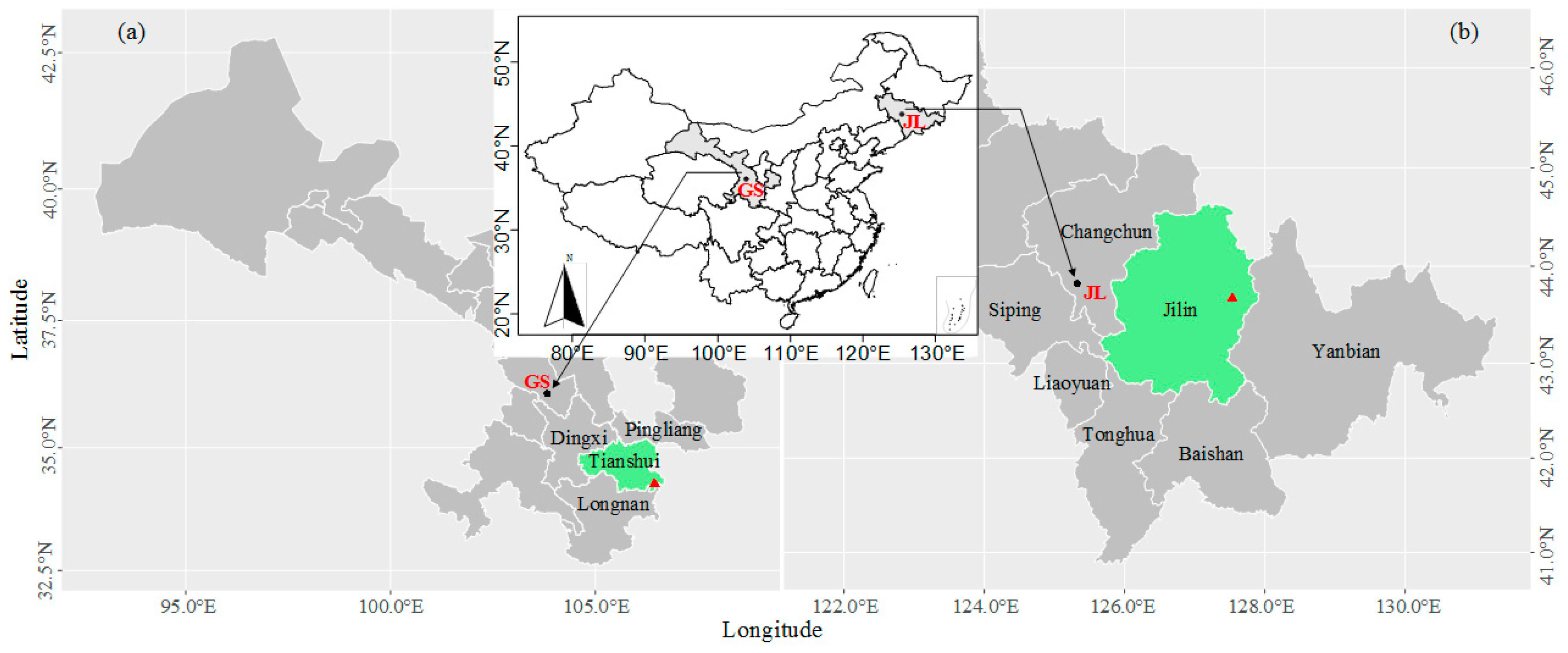
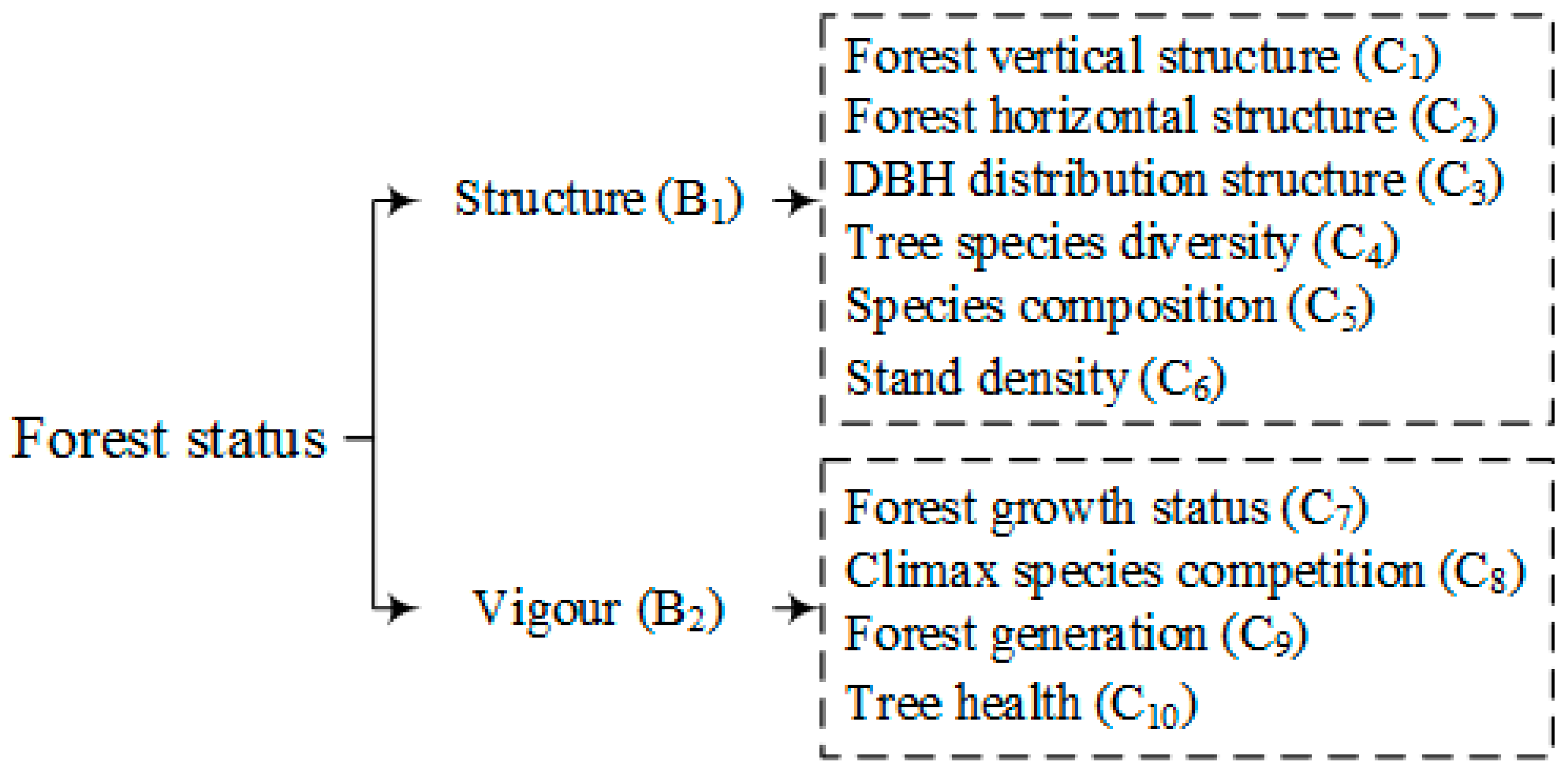

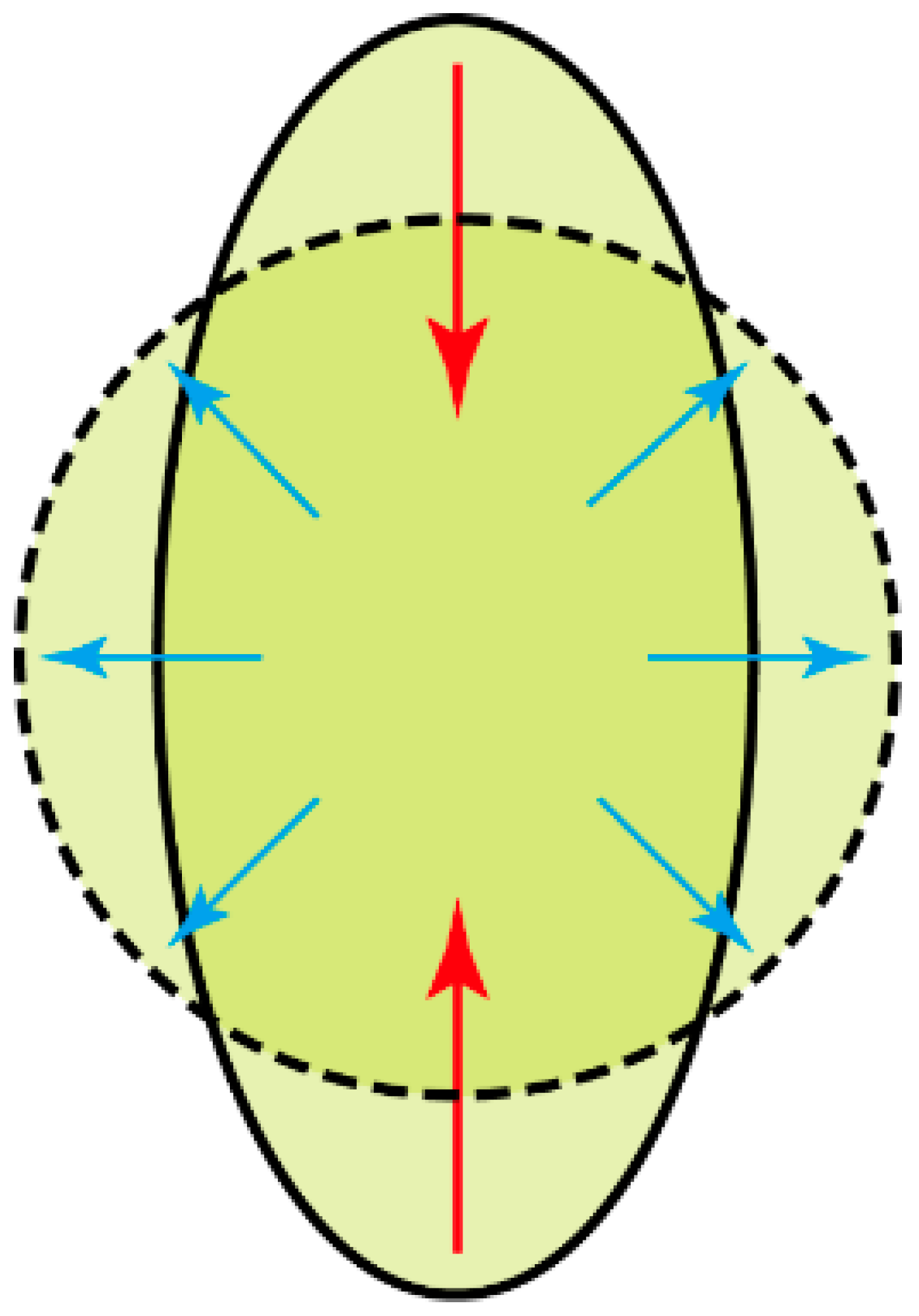
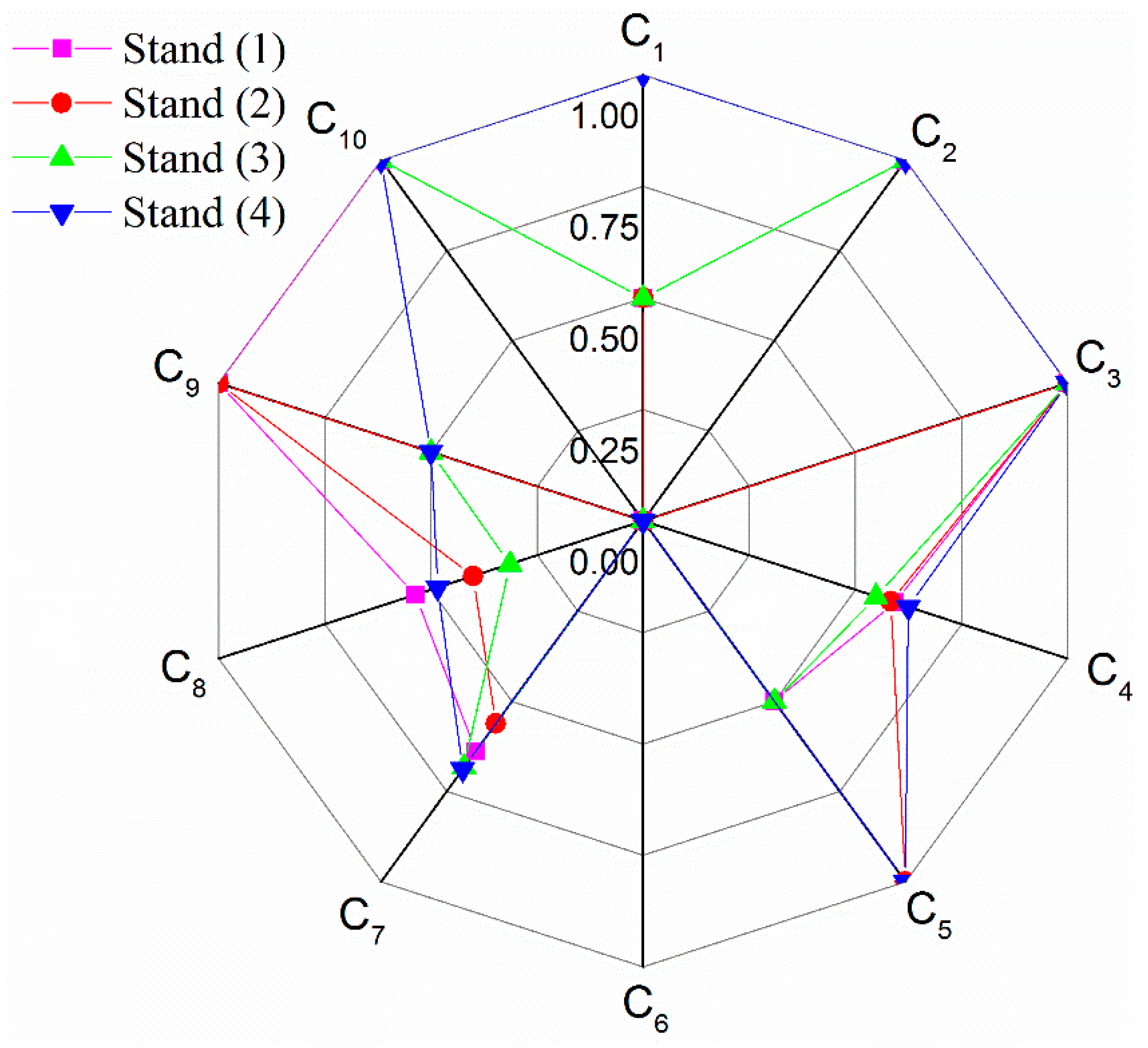
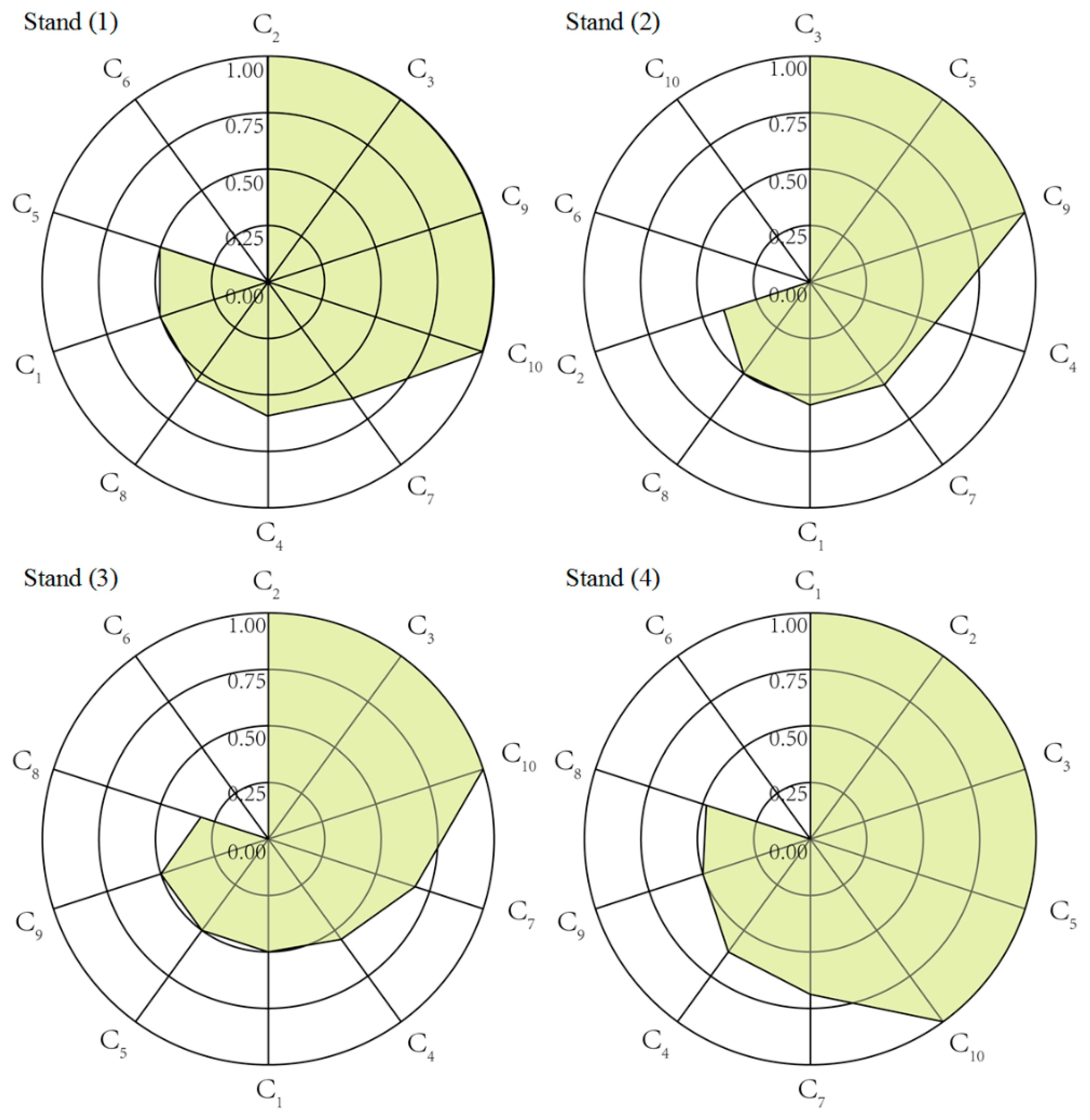
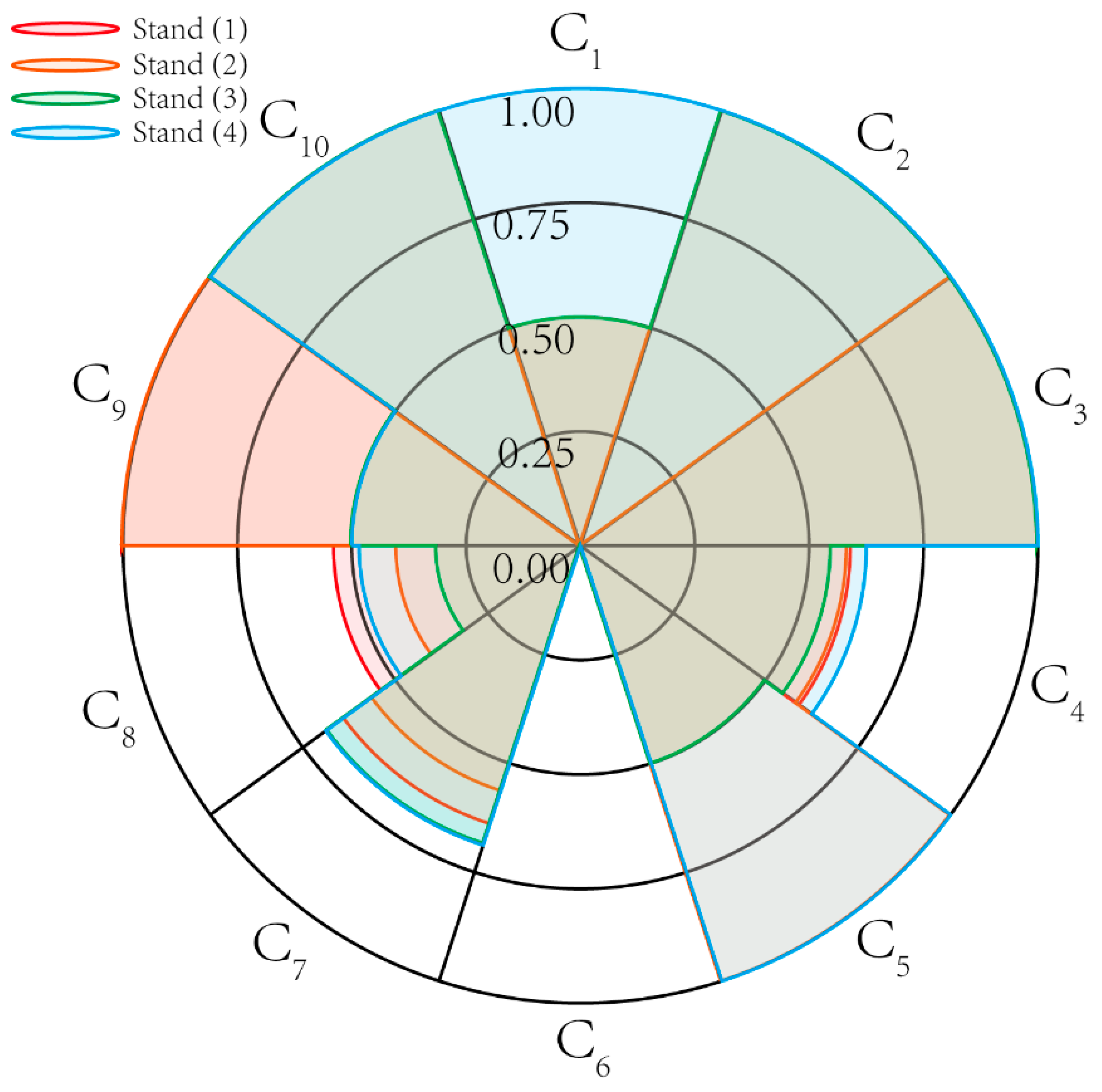
| Stand | Forest Type | Plot Size (m2) | Species No. | Slope Gradient (°) | Slope Aspect | Altitude (m) | Basal Area (m2·ha−1) | Mean DBH (cm) | Density (N·ha−1) |
|---|---|---|---|---|---|---|---|---|---|
| (1) | Q. aliena var. acuteserrata mixed forest | 70 × 70 | 33 | 12 | NW | 1720 | 27.9 | 19.5 | 933 |
| (2) | 70 × 70 | 35 | 12 | NW | 1700 | 25.3 | 19.6 | 842 | |
| (3) | P. koraiensis broad-leaved mixed forest | 100 × 100 | 20 | 17 | NW | 660 | 31.3 | 18.1 | 1186 |
| (4) | 100 × 100 | 22 | 8 | NW | 600 | 31.9 | 22.1 | 800 |
| Stand | ||||||||||
|---|---|---|---|---|---|---|---|---|---|---|
| (1) | 1.9/0.5 | 0.492/1 | Inverted J shape/1 | 0.593 | 2/0.5 | 0.633/0 | 0.638 | 0.537 | 8100/1 | 96.5%/1 |
| (2) | 1.9/0.5 | 0.533/0 | Inverted J shape/1 | 0.584 | 3/1 | 0.554/0 | 0.562 | 0.401 | 7480/1 | 87.1%/0 |
| (3) | 2.2/0.5 | 0.499/1 | Inverted J shape/1 | 0.549 | 2/0.5 | 0.660/0 | 0.683 | 0.314 | 2300/0.5 | 90.9%/1 |
| (4) | 2.5/1 | 0.491/1 | Inverted J shape/1 | 0.625 | 3/1 | 0.643/0 | 0.688 | 0.484 | 720/0.5 | 92.9%/1 |
| Stand | Radar Plot | Unit Circle | New Method Based on Unit Circle | |||||||
|---|---|---|---|---|---|---|---|---|---|---|
| Rank | Rank | Rank | ||||||||
| (1) | 1.402 | 2 | 1.614 | 2 | 1.743 | 4.252 | 0.555 | 1.211 | 0.820 | 2 |
| (2) | 0.527 | 4 | 1.180 | 4 | 1.278 | 3.171 | 0.407 | 1.597 | 0.806 | 3 |
| (3) | 1.086 | 3 | 1.326 | 3 | 1.450 | 3.799 | 0.462 | 1.263 | 0.764 | 4 |
| (4) | 1.565 | 1 | 1.860 | 1 | 1.994 | 4.585 | 0.635 | 1.192 | 0.870 | 1 |
© 2018 by the authors. Licensee MDPI, Basel, Switzerland. This article is an open access article distributed under the terms and conditions of the Creative Commons Attribution (CC BY) license (http://creativecommons.org/licenses/by/4.0/).
Share and Cite
Zhang, G.; Hui, G.; Zhang, G.; Hu, Y.; Zhao, Z. A Novel Comprehensive Evaluation Method of Forest State Based on Unit Circle. Forests 2019, 10, 5. https://doi.org/10.3390/f10010005
Zhang G, Hui G, Zhang G, Hu Y, Zhao Z. A Novel Comprehensive Evaluation Method of Forest State Based on Unit Circle. Forests. 2019; 10(1):5. https://doi.org/10.3390/f10010005
Chicago/Turabian StyleZhang, Ganggang, Gangying Hui, Gongqiao Zhang, Yanbo Hu, and Zhonghua Zhao. 2019. "A Novel Comprehensive Evaluation Method of Forest State Based on Unit Circle" Forests 10, no. 1: 5. https://doi.org/10.3390/f10010005
APA StyleZhang, G., Hui, G., Zhang, G., Hu, Y., & Zhao, Z. (2019). A Novel Comprehensive Evaluation Method of Forest State Based on Unit Circle. Forests, 10(1), 5. https://doi.org/10.3390/f10010005





